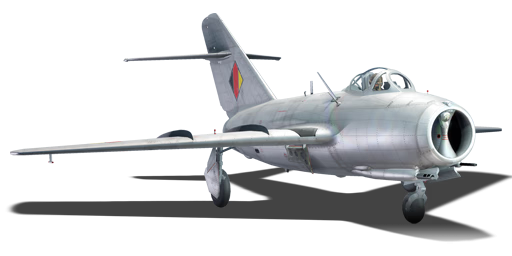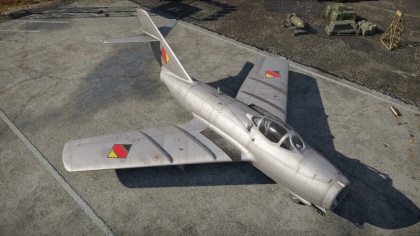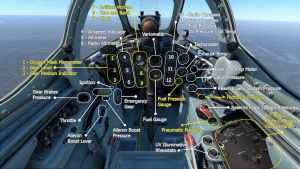Difference between revisions of "MiG-15bis (Germany)"
(Edits.) |
(Reconfig In-game description info section.) |
||
| Line 244: | Line 244: | ||
== History == | == History == | ||
''Describe the history of the creation and combat usage of the aircraft in more detail than in the introduction. If the historical reference turns out to be too big, take it to a separate article, taking a link to an article about the vehicle and adding a block "/ historical reference" (example: https://wiki.warthunder.com/Name-vehicles/historical reference) and add a link to it here using the <code>main</code> template. Be sure to include links to sources at the end of the article.'' | ''Describe the history of the creation and combat usage of the aircraft in more detail than in the introduction. If the historical reference turns out to be too big, take it to a separate article, taking a link to an article about the vehicle and adding a block "/ historical reference" (example: https://wiki.warthunder.com/Name-vehicles/historical reference) and add a link to it here using the <code>main</code> template. Be sure to include links to sources at the end of the article.'' | ||
| + | |||
| + | === In-game description === | ||
| + | "After World War II was over, the leaders of the USSR realized that they were behind the leading states of the world in the sphere of jet aircraft construction, most notably in the full-scale production of turbojet engines. Consequently, a delegation including the designers A. I. Mikoyan and V. Y. Klimov was sent to Great Britain towards the end of 1946. Their negotiations were successful, resulting in the purchase of two of the most advanced turbojet engines at that time: the Rolls-Royce Derwent Mk.V and the Rolls-Royce Nene I/Nene II. The British consented to sell their newest strategic designs easily enough, since they believed that the Soviet industrial/technological apparatus could not handle the mass production of sophisticated assemblies. However, very soon that the Rolls-Royce engines were launched into full-scale Soviet production under the designations RD-500 and RD-45. | ||
| + | |||
| + | The emergence of the new engines led to the creation of Soviet jet fighters able to compete with the leading models of the world. In 1947, the Mikoyan Design Bureau started the development of a front line fighter with a Nene (RD-45) turbojet engine and an airtight cockpit: the I-310 (""S""). The first S-01 prototype aircraft made its first flight on December 30, 1947, and, after working on the test results, was launched into full-scale production in 1948 under the designation MiG-15. The plane's airframe was an all-metal monoplane configuration with mid-swept wings and empennage. Thus the MiG-15 became the first production swept-wing fighter. | ||
| + | |||
| + | The MiG-15 was equipped with a RD-45F single-shaft turbojet engine rated at 2,270 kg of thrust with a double-entry centrifugal compressor. The plane's armament included a 37mm Nudelman N-37D cannon with 40 rounds and two 23mm Nudelman-Suranov NS-23KM guns with 160 rounds in total. The cannons were mounted in the forward fuselage on a lowerable carriage. Two 100-kg or 50-kg bombs could be suspended under the wings. To increase its flight range, the aircraft could carry two external fuel tanks with a capacity ranging from 250 to 600 liters. | ||
| + | |||
| + | The MiG-15 fighter was notable for its simple and reliable structure, high flight and operating characteristics, and powerful armament. Its maximum speed, rate of climb, ceiling, and flight range were the best among Soviet fighters at the time and superior to many foreign aircraft, as well. | ||
| + | |||
| + | The first production MiG-15s with RD-45F engines began to leave the factory floor in early 1949. In 1950, more advanced MiG-15bis fighters replaced them in the factory assembly lines." | ||
== Media == | == Media == | ||
Revision as of 12:09, 9 May 2019
Contents
| This page is about the German jet fighter MiG-15bis (Germany). For other uses, see MiG-15 (Family). |
Description
The ◊MiG-15bis is a rank V German jet fighter
with a battle rating of 8.7 (AB/SB) and 8.3 (RB).
General info
Flight Performance
| Characteristics | |||||||
|---|---|---|---|---|---|---|---|
| Stock | |||||||
| Max Speed (km/h at 0 m) |
Max altitude (meters) |
Turn time (seconds) |
Rate of climb (meters/second) |
Take-off run (meters) | |||
| AB | RB | AB | RB | AB | RB | ||
| 1,062 | 1,046 | 15500 | 21.0 | 22.0 | 41.4 | 39.8 | 475 |
| Upgraded | |||||||
| Max Speed (km/h at 0 m) |
Max altitude (meters) | Turn time (seconds) | Rate of climb (meters/second) |
Take-off run (meters) | |||
| AB | RB | AB | RB | AB | RB | ||
| ? | ? | 15500 | ??.? | ??.? | ??.? | ??.? | 475 |
Details
| Features | ||||
|---|---|---|---|---|
| Combat flap | Take-off flap | Landing flap | Air brakes | Arrestor gear |
| X | ✓ | ✓ | ✓ | X |
| Limits | ||||
|---|---|---|---|---|
| Wing-break speed (km/h) |
Gear limit (km/h) |
Combat flap (km/h) |
Max Static G | |
| + | - | |||
| 0 | 450 | 650 | ~20 | ~8 |
| Optimal velocities | |||
|---|---|---|---|
| Ailerons (km/h) |
Rudder (km/h) |
Elevators (km/h) |
Radiator (km/h) |
| < 600 | < 700 | < 750 | > ??? |
| Compressor (RB/SB) | ||
|---|---|---|
| Setting 1 | ||
| Optimal altitude | 100% Engine power | WEP Engine power |
| 0 m | 2450 kgf | No WEP |
Survivability and armour
- 10 mm steel armour plates in front of the cockpit and behind the pilot's head rest.
- 6 mm steel armour under the pilot's seat.
- 64 mm bulletproof front windshield.
- Self-sealing fuel tanks behind the pilot and under the jet engine nozzle.
- Jet engine located in the rear of the aircraft, pilot seated in front.
Armaments
Offensive armament
- 2 x 23 mm Nudelman–Rikhter NR-23 cannon (80 rounds/gun)
- 1 x 37 mm Nudelman N-37D cannon (40 rounds/gun)
Suspended armament
- 2 x 100 kg FAB-100 bombs
- 2 x 250 kg FAB-250 bombs
- 2 x ORO-57K rocket pods
- 2 x 8 x 57 mm S-5M rockets (HE)
- 2 x 8 x 57 mm S-5K rockets (HEAT)
- 2 x 210 mm S-21 rockets
Usage in the battles
The most common enemy of the MiG-15bis is, of course, the F-86 Sabre's although the Banshee/Panther/Cougar line is also a threat. The MiG's main disadvantage is its wing is vulnerable to ripping in the rolling turn. The Sabre doesn't have this same issue so don't try to out-roll the Sabre, use your extremely good energy retention to zoom back up to higher altitude and then re-engage in a dive.
Manual Engine Control
| MEC elements | ||||||
|---|---|---|---|---|---|---|
| Mixer | Pitch | Radiator | Supercharger | Turbocharger | ||
| Oil | Water | Type | ||||
| Not controllable | Not controllable | Not controllable | Not controllable | Separate | Not ontrollable | Not controllable |
Modules
| Tier | Flight performance | Survivability | Weaponry | |||
|---|---|---|---|---|---|---|
| I | Fuselage Repair | Radiator | Offensive 23 mm | |||
| II | Compressor | Airframe | New 23 mm cannons | S5K | ||
| III | Wings Repair | Engine | Offensive 37 mm | S5M | BD-2-48 | |
| IV | Engine Injection | Cover | New 37 mm cannons | S21 | ||
Pros and cons
Pros:
- Great acceleration
- Superior climb rate
- Powerful armament
- Low wing loading which results in great maneuverability
- Great in vertical maneuvers
- Good flaps that allow them to be deployed even at high speeds (up to 800 kph IAS)
- High service ceiling
- Excellent high altitude performance
Cons:
- Low roll rate especially at high speeds
- Control surfaces are highly stiffening at high speeds
- Hard to aim due low velocity guns
- Guns can spark frequently
- Low amount of ammo
- Long turn times
History
Describe the history of the creation and combat usage of the aircraft in more detail than in the introduction. If the historical reference turns out to be too big, take it to a separate article, taking a link to an article about the vehicle and adding a block "/ historical reference" (example: https://wiki.warthunder.com/Name-vehicles/historical reference) and add a link to it here using the main template. Be sure to include links to sources at the end of the article.
In-game description
"After World War II was over, the leaders of the USSR realized that they were behind the leading states of the world in the sphere of jet aircraft construction, most notably in the full-scale production of turbojet engines. Consequently, a delegation including the designers A. I. Mikoyan and V. Y. Klimov was sent to Great Britain towards the end of 1946. Their negotiations were successful, resulting in the purchase of two of the most advanced turbojet engines at that time: the Rolls-Royce Derwent Mk.V and the Rolls-Royce Nene I/Nene II. The British consented to sell their newest strategic designs easily enough, since they believed that the Soviet industrial/technological apparatus could not handle the mass production of sophisticated assemblies. However, very soon that the Rolls-Royce engines were launched into full-scale Soviet production under the designations RD-500 and RD-45.
The emergence of the new engines led to the creation of Soviet jet fighters able to compete with the leading models of the world. In 1947, the Mikoyan Design Bureau started the development of a front line fighter with a Nene (RD-45) turbojet engine and an airtight cockpit: the I-310 (""S""). The first S-01 prototype aircraft made its first flight on December 30, 1947, and, after working on the test results, was launched into full-scale production in 1948 under the designation MiG-15. The plane's airframe was an all-metal monoplane configuration with mid-swept wings and empennage. Thus the MiG-15 became the first production swept-wing fighter.
The MiG-15 was equipped with a RD-45F single-shaft turbojet engine rated at 2,270 kg of thrust with a double-entry centrifugal compressor. The plane's armament included a 37mm Nudelman N-37D cannon with 40 rounds and two 23mm Nudelman-Suranov NS-23KM guns with 160 rounds in total. The cannons were mounted in the forward fuselage on a lowerable carriage. Two 100-kg or 50-kg bombs could be suspended under the wings. To increase its flight range, the aircraft could carry two external fuel tanks with a capacity ranging from 250 to 600 liters.
The MiG-15 fighter was notable for its simple and reliable structure, high flight and operating characteristics, and powerful armament. Its maximum speed, rate of climb, ceiling, and flight range were the best among Soviet fighters at the time and superior to many foreign aircraft, as well.
The first production MiG-15s with RD-45F engines began to leave the factory floor in early 1949. In 1950, more advanced MiG-15bis fighters replaced them in the factory assembly lines."
Media
An excellent addition to the article will be video guides, as well as screenshots from the game and photos.
Read also
Links to the articles on the War Thunder Wiki that you think will be useful for the reader, for example,
- reference to the series of the aircraft;
- links to approximate analogues of other nations and research trees.
Sources
Paste links to sources and external resources, such as:
- topic on the official game forum;
- page on aircraft encyclopedia;
- other literature.
| Germany jet aircraft | |
|---|---|
| |
Luftwaffe |
| He 162 | He 162 A-1 · He 162 A-2 |
| Me 163 | Me 163 B · Me 163 B-0 |
| Ho 229 | Ho 229 V3 |
| Ar 234 | Ar 234 B-2 · Ar 234 C-3 |
| Me 262 | Me 262 A-1a · Me 262 A-1a/Jabo · Me 262 A-1a/U1 · Me 262 A-1/U4 · Me 262 A-2a |
| Me 262 C-1a · Me 262 C-2b | |
| |
LSK |
| Fighters | ◊MiG-15bis · ◊Lim-5P · ◊MiG-19S |
| ◊MiG-21MF · ◊MiG-21bis-SAU · ◊MiG-21 "Lazur-M" | |
| ◊MiG-29 | |
| Attackers | ◊MiG-23BN · ◊MiG-23MF · ◊MiG-23MLA |
| ◊Su-22UM3K · ◊Su-22M4 | |
| ◊IL-28 | |
| |
Luftwaffe |
| F-84 | ◄F-84F |
| F-86 | ◄CL-13A Mk 5 · ◄CL-13B Mk.6 · ◄F-86K |
| F-104 | ◄F-104G |
| F-4 | ◄F-4F Early · ◄F-4F · ◄F-4F KWS LV |
| G.91 | ◄G.91 R/3 · ◄G.91 R/4 |
| Tornado | ◄Tornado IDS WTD61 · ◄Tornado IDS MFG · ◄Tornado IDS ASSTA1 |
| Other | Alpha Jet A · ◄Sea Hawk Mk.100 |
| Ex-LSK | ◄MiG-21 SPS-K · ◄MiG-29G · ◄Su-22M4 WTD61 |
| |
Swiss Air Force |
| ◌Hunter F.58 · FFA P-16 | |






